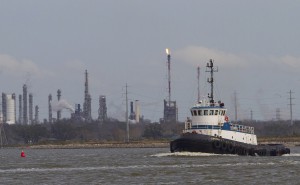Pollution From Ship Channel and Port Traffic Affects Galena Park

REUTERS /RICHARD CARSON /LANDOV
A tug boat navigates the Houston ship channel with a flare from an oil refinery and storage facility in the background south of downtown Houston
The city of Galena Park is on the north side of the Ship Channel, surrounded by highways, freight rail lines and heavy industry.
It has about 10,000 residents.
The city’s main road, Clinton Drive, is a major artery for the Port of Houston and Ship Channel industries, according to Bel Vasquez-St. John, community outreach director for the environmental group Air Alliance Houston.
Vasquez-St. John says thousands of tractor trailers pass through Galena Park every day.
“There’s just so many going and coming that it makes it very unsafe, for even the drivers coming in to Galena Park,” she said.
Houston Air Alliance placed five air pollution monitors throughout Galena Park.
The monitors looked specifically at fine particulate matter, which is compromised of soot, dust, smoke and even liquid air droplets – all tiny particles that can lodge deep in the lungs. The group wanted to check if their monitors found different levels of fine particulates when compared to a nearby state monitor put in place by the Texas Commission on Environmental Quality (TCEQ).
The group’s monitors did not find any statistically significant difference on measurements of fine particulate matter. However, the new monitors also took measurements of elemental carbon, which is not something that the TCEQ tracks on its own monitors.
Elemental carbon can help indicate the amount of diesel engine exhaust in an area.
Adrian Shelley, Houston Air Alliance’s executive director, said the results were disturbing:
“We found an elevated cancer risk due to exposure to diesel pollution, maybe as high as one in ten thousand,” Shelley said. “An acceptable cancer risk is generally considered to be one in a million. So we are finding a potential cancer risk in that community that is well above what is considered to be acceptable.”
So what should be done?
Shelley says the port authority needs to deal with the traffic jams, because trucks can sometimes idle for hours, waiting to get in to port facilities.
He suggested the port create a dedicated lane for trucks, away from neighborhoods.
And it could provide truck stops where drivers can rest and wait instead of running their engines for hours.
He also suggested that cities that surround the port, like Houston and Galena Park, could pass their own laws to prevent trucks from idling.
“If we were to pass a no-idling ordinance, it would restrict heavy duty trucks from idling for more than five minutes at a time,” Shelley said. “It’s a simple, common sense measure. It would improve public health by reducing air pollution and in fact it would save money for the drivers.”
Shelley said no-idling ordinances are a proven strategy: Austin and Dallas have them, and they’re in use at the country’s largest port in Los Angeles.
Houston Port officials did not immediately return a request for comment.
